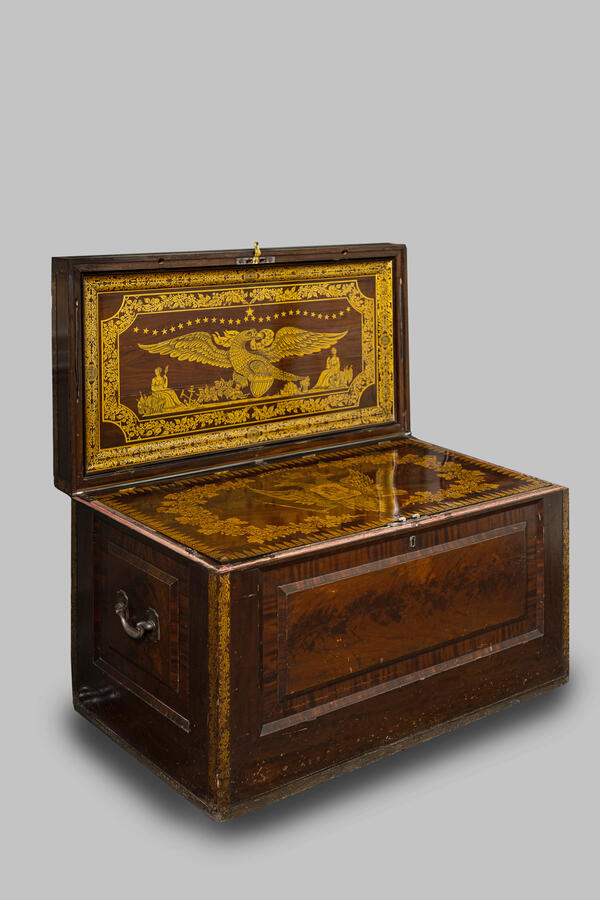A wooden cigar box was one of the first exhibits of the Volsk Museum of Local History. It was delivered in 1920 from the estate of the Minister of Foreign Affairs and Chancellor of the Russian Empire, Count Karl Nesselrode. He was in charge of the department from 1816 to 1856.
Karl Nesselrode loved music and fine art, and during his years of service, he amassed a substantial collection of paintings by Dutch, Flemish, Italian, and Spanish masters. After he retired, he sent most of it to his estate in the Tsarevschina village, which he had bought in the 1810s from the widow of Saratov Governor Alexander Vyazemsky. In addition to the paintings, antique pieces of furniture and the chancellor’s extensive library were also moved into the house.
Emperor Nicholas I presented this cigar box to Karl Nesselrode in person. It was a gift to the Russian tsar from the delegation of the American Congress at an important meeting in 1845. The meeting was directly presided over by Count Nesselrode, who was then the Minister of Foreign Affairs.
This rectangular box was made of wood in 1845 in New York City. Its top hinged lid is flat, and another lid, the thinner one, is attached to its inner surface by hinges. The inside of the top lid is decorated around the perimeter with a floral ornament, with an eagle, as it is the symbol of the United States of America, and 29 stars in the center. There are images of women on either side of the drawing.
The lower lid is painted on top with the image of the Russian double-headed eagle with the inscription NICHOLAI 1th (Nicholas I). The eagle holds a shield with the image of George the Victorious slaying the dragon with his spear. This picture is a simplified version of the state emblem of the Russian Empire.
On the underside of the bottom lid in a figured frame are the date and place of manufacture of the box — 1845, New York, USA.
Inside the box, there are three rows of varying volumes for storing cigars and smoking devices. Different varieties of cigars were stored separately so that their scents would not mix. The inside of the box can be pulled on to reveal a hidden compartment.
Karl Nesselrode loved music and fine art, and during his years of service, he amassed a substantial collection of paintings by Dutch, Flemish, Italian, and Spanish masters. After he retired, he sent most of it to his estate in the Tsarevschina village, which he had bought in the 1810s from the widow of Saratov Governor Alexander Vyazemsky. In addition to the paintings, antique pieces of furniture and the chancellor’s extensive library were also moved into the house.
Emperor Nicholas I presented this cigar box to Karl Nesselrode in person. It was a gift to the Russian tsar from the delegation of the American Congress at an important meeting in 1845. The meeting was directly presided over by Count Nesselrode, who was then the Minister of Foreign Affairs.
This rectangular box was made of wood in 1845 in New York City. Its top hinged lid is flat, and another lid, the thinner one, is attached to its inner surface by hinges. The inside of the top lid is decorated around the perimeter with a floral ornament, with an eagle, as it is the symbol of the United States of America, and 29 stars in the center. There are images of women on either side of the drawing.
The lower lid is painted on top with the image of the Russian double-headed eagle with the inscription NICHOLAI 1th (Nicholas I). The eagle holds a shield with the image of George the Victorious slaying the dragon with his spear. This picture is a simplified version of the state emblem of the Russian Empire.
On the underside of the bottom lid in a figured frame are the date and place of manufacture of the box — 1845, New York, USA.
Inside the box, there are three rows of varying volumes for storing cigars and smoking devices. Different varieties of cigars were stored separately so that their scents would not mix. The inside of the box can be pulled on to reveal a hidden compartment.



